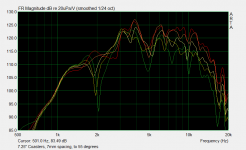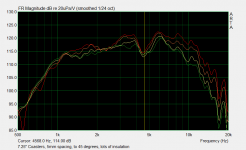Smith horn...
I would worry the reflection back down the throat from the
sudden discontinuity at the outer edge, uniformly the same
distance all around. You might get better results to put the
driver off-center, or cut some scallops into the upper plate
like JBL Aquarius...
I would worry the reflection back down the throat from the
sudden discontinuity at the outer edge, uniformly the same
distance all around. You might get better results to put the
driver off-center, or cut some scallops into the upper plate
like JBL Aquarius...
Lots of standing waves, but almost Omni radiation - with a lot of coloration from the standing waves. You could reduce the coloration with some randomness as suggested above, but then you would also get some random directivity. It would have a hugely "spacious" sound as a result.
Standing waves from the edges, or from in front of the driver, or both? It's not so much that I think this is a good idea as I want to understand how bad it is. I was also wondering about doing this with a round planar, or two opposing ones. I suppose I could just try it and measure for myself, hardly the most difficult thing to build.
Last edited:
Example
https://www.google.com/patents/US4496021
Regards,
WHG
...and mounted it flush in the middle of a big disc pointing up, and then I had a matching disc in above that, 0.25"-ish away so that the cross section at the exit is the same as in the exit? I get 360° of... what?
https://www.google.com/patents/US4496021
Regards,
WHG
Sure, I can imagine all kinds of things like that (and some of them are commercial products), but I'm more interested in just how bad it is to do it the easy way. The easy way definitely can't involve any kind of phase plugs not already attached to the driver, nor any kind of expansion different than that already provided by the circles. Just two flat pieces, and a half- or quarter-circle roundover at the exit.
Last edited:
Your standing waves are from the driver to the edge of the plates.
Simultaneously too wide and too narrow to support other internal
modes. There are also room modes to worry. But in this plan, the
horn's length (and harmonics of length) will dominate.
If you can equalize the exiting sound (the big if), corrections will
apply equally in every direction. That's constant directivity for you.
Simultaneously too wide and too narrow to support other internal
modes. There are also room modes to worry. But in this plan, the
horn's length (and harmonics of length) will dominate.
If you can equalize the exiting sound (the big if), corrections will
apply equally in every direction. That's constant directivity for you.
?
If it is so easy to build, then do that and observe the results to determine which of the imagined shortcomings are important and which ones are not; otherwise, simply settle for conjecture to avoid that effort. The difference between your imagined design and the example provided are most likely what is important to make the effort a success.
WHG
Sure, I can imagine all kinds of things like that (and some of them are commercial products), but I'm more interested in just how bad it is to do it the easy way. The easy way definitely can't involve any kind of phase plugs not already attached to the driver, nor any kind of expansion different than that already provided by the circles. Just two flat pieces, and a half- or quarter-circle roundover at the exit.
If it is so easy to build, then do that and observe the results to determine which of the imagined shortcomings are important and which ones are not; otherwise, simply settle for conjecture to avoid that effort. The difference between your imagined design and the example provided are most likely what is important to make the effort a success.
WHG
Lots of standing waves, but almost Omni radiation - with a lot of coloration from the standing waves. You could reduce the coloration with some randomness as suggested above, but then you would also get some random directivity. It would have a hugely "spacious" sound as a result.
I've built a bunch of these over the last couple years. Some observations:
1) I personally think that a 'true' radial horn is basically useless, because the reflection off of the room is so strong. IE, I want *less* reflections, not more.
Here is a measurement of a radial horn using the BG NEO 3. We see the strong standing waves which are caused by the symmetry of the device, both radially and vertically:
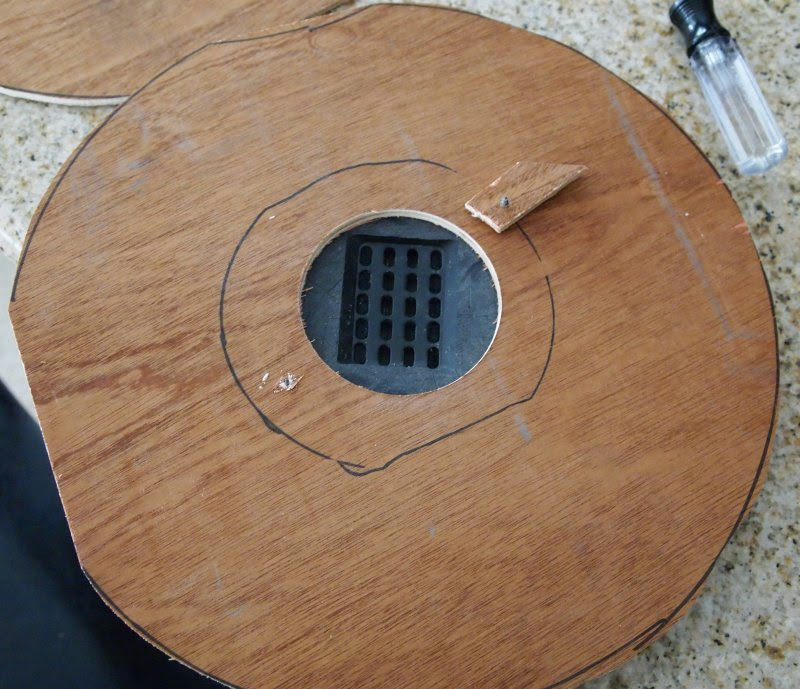
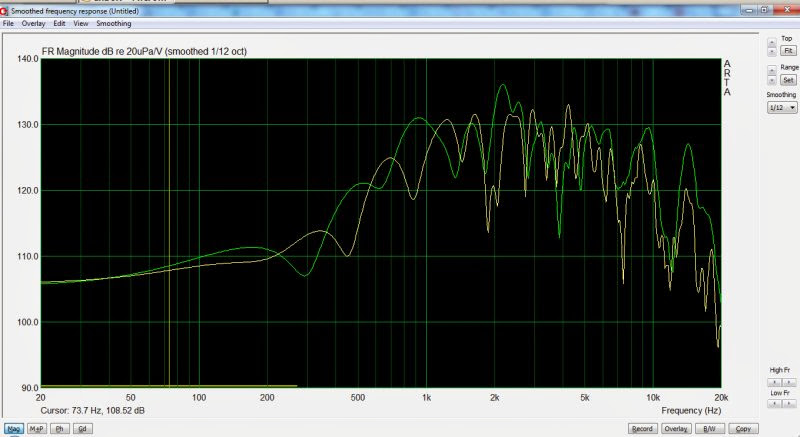
2) For my money, you can make a *huge* improvement in the frequency response, impulse response, and directivity by adding a simple baffle inside of the radial horn. By doing this, you change the radiation pattern from 360 degrees to 180s horizontally. The vertical directivity depends on the height of the platters. Make the height very small and you get wide vertical directivity; make the height very tall and you get narrow vertical directivity. And obviously, "tall" is a subjective term. For instance, a height of 7" is sufficient to constrain the vertical directivity down to approximately 2khz.

Here's an example of this. By adding a baffle, we've constrained the radiation of the driver into the forward lobe. It's especially noticeable on the backside of the device; now the levels are down by ten decibels at the back. In the pic above, yellow is on axis, orange is 22.5 degrees off axis, and red is 45. Grey is at the back.
Note how the peaks and dips from the first measurement are less severe, the overall response shape is smoother?
I think this is a really nice solution for the home or for the car. Because you have even coverage on and off axis, like a 'real' waveguide. But you aren't sending copious amounts of output into the back wall.
I need to figure out how to do proper polars in Arta and see if this is 'cardioid like.'
Some of you may assume that the second measurement crushes the first measurement because the second measurement uses a compression driver, while the first uses a planar magnetic. I considered that too, but found that the radial horn with a Dayton D250P performed poorly also.
Long story short:
If you're going to do a radial horn, I would strongly encourage you to put a baffle in it, to change the radiation from 360 to 180.
More details here:
http://www.diyaudio.com/forums/multi-way/239808-28-days-later-3.html
Well, I got to thinking about this because I am working on a few versions of a mono, outdoor speaker, so questionable nature of omni in the home doesn't play into it. One small bipolar version was shaping up to be not so far from 360° into the upper mids, so I thought "why not take it all the way up through the HF?". Then I thought "because that's difficult to build and/or expensive and this project is neither", then this.
Well, I got to thinking about this because I am working on a few versions of a mono, outdoor speaker, so questionable nature of omni in the home doesn't play into it. One small bipolar version was shaping up to be not so far from 360° into the upper mids, so I thought "why not take it all the way up through the HF?". Then I thought "because that's difficult to build and/or expensive and this project is neither", then this.
Note that output is generally limited by displacement; so a 360 degree tweeter won't have a lot of output capability. The fact that a compression driver has an efficiency in the high 100s is deceiving, because at it's core it's still a 2" diaphragm with virtually no excursion.
But if you use a very high crossover point, yes, it would probably work OK.
I'd probably put it a little bit off center; symmetry makes the peaks and dips in these things quite brutal, and mounting the radiator off center breaks up the symmetry.
If I can find some circles I can give it a try after work. I have something else to measure tonight anyway. You'd think I'd have some driver cutouts, but there were a lot of campfires this summer. I have some 8" cork circles...
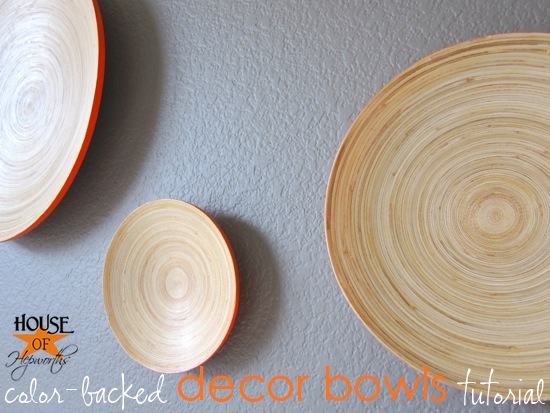
Once I get around to building some DIY Beolab5s, I am going to use Ikea plates ^^^
Some reasons you might consider it:
1) Due to the flare, they have less diffraction than a disc
2) Due to the variation in the height, they have better frequency response than a plain ol' disc
3) they're pretty
4) they're less than $10 each
5) bamboo is almost as strong as aluminum, but better damped
6) the center of the bamboo plate is flat, which is ideal for mounting your drivers
7) With a diameter of 12", the Ikea plates are wide enough to constrain the compression driver's directivity down to 1125hz... just about perfect for a compression driver
8) With a radius of 6", the Ikea plates have a quarter wave resonance of 563hz. This adds some much needed gain to the low end, and should help their power handling
Hmm, you'll have to cut this off:
An externally hosted image should be here but it was not working when we last tested it.
I probably should have mentioned most of the drop in level there, if not all of it, is because I just raised the mic without keeping the distance equal (didn't seem to be much point, we know the pattern will be real wide).
That was with the whole thing on the corner of a speaker cabinet. I moved it to the top of a shipping tube, which makes the measurements a little more tidy in the way they change off-axis, but that really only clarifies that having an equal distance to a problem over 360° is kind of a problem. You can mess with it a LOT and get pretty much the same response issues.
That was with the whole thing on the corner of a speaker cabinet. I moved it to the top of a shipping tube, which makes the measurements a little more tidy in the way they change off-axis, but that really only clarifies that having an equal distance to a problem over 360° is kind of a problem. You can mess with it a LOT and get pretty much the same response issues.
- Status
- This old topic is closed. If you want to reopen this topic, contact a moderator using the "Report Post" button.
- Home
- Loudspeakers
- Multi-Way
- What would happen if I took a 1" exit compression driver...
